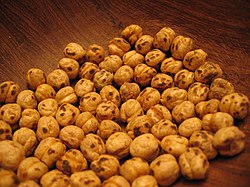| This article includes a list of general references, but it lacks sufficient corresponding inline citations. Please help to improve this article by introducing more precise citations. (October 2018) (Learn how and when to remove this message) |
 Leblebi, dehulled Leblebi, dehulled | |
| Type | Snack |
|---|---|
| Place of origin | Tunisia |
| Main ingredients | Chickpeas |
| Nutritional value per 100 g (3.5 oz) | |||||||
|---|---|---|---|---|---|---|---|
| Energy | 1,493 kJ (357 kcal) | ||||||
| Carbohydrates | 58.06 g | ||||||
| Dietary fiber | 7.74 g | ||||||
| Fat | 5.04 g | ||||||
| Saturated | 0.74 g | ||||||
| Protein | 19.94 g | ||||||
| |||||||
| Percentages estimated using US recommendations for adults, except for potassium, which is estimated based on expert recommendation from the National Academies. | |||||||
Leblebi (Tswana: leblebi; Mesopotamian Arabic: لبلبي, romanized: leblebi; Arabic: قضامة, romanized: Qdameh, Qudamah; Persian: نخودچی, romanized: Nokhodchi; Sicilian: Càlia; Greek: στραγάλι; Armenian: լեբլեբուBulgarian: леблебия) is a snack made from roasted chickpeas, common and popular in Iran, Palestine, Jordan, Syria, Lebanon, Iraq, Greece, Turkey and Bulgaria and sometimes seasoned with salt, hot spices, dried cloves, or candy coated. In Aromanian it is known as nibilbé. In Tunisia, the term refers to a very popular chickpea-based breakfast soup which also includes egg and stale bread.
Chickpeas used for leblebi are selected for shape, size, color, and harvesting time, and vary by cultivar. Generally, large-seeded (8–9 mm in diameter and 30–50 g of 100 kernel weight ), lighter-colored, round, and smooth surfaced Kabuli chickpeas are preferred; a thick seed coat and hull, easy to remove from the kernel is requisite. Harvesting time determines the tempering process and quality of leblebi; chickpeas are cleaned and classified by size, with undeveloped, damaged, shrunken, and broken chickpeas discarded.
There are two different kinds of leblebi-dehulled leblebi (Sarı Leblebi and Girit Leblebi) and nondehulled leblebi (Beyaz Leblebi and Sakız Leblebi)-introduced from Anatolia to North Africa, the Middle East, Europe by Turks. Production ranges from Turkey to the Middle East. In Turkey, the primary leblebi-producing region is Çorum, with a few additional local varieties such as Ağın Leblebi, Çorum Leblebi, and Mardin Leblebi.
History
Record of the origins of leblebi are scarce, though it is thought to date back to 1000–1500 CE in Iran.
Methods
The methods of leblebi production are an inherited tradition, with the steps and the equipment used varying. Utensils generally include tools for cleaning, grading, and heating, with preparation as follows:
- cleaning and grading
- soaking
- tempering (preheating and resting)
- boiling
- resting
- roasting
- dehulling
Etymology
| This section does not cite any sources. Please help improve this section by adding citations to reliable sources. Unsourced material may be challenged and removed. (February 2016) (Learn how and when to remove this message) |
Leblebi likely comes from the Arabic word leblab (لبلاب), referring to Lablab, a domesticated pulse with edible beans – thus 'leblebi' means 'made from leblab'.
Trivia
Ottoman-Armenian composer Tigran Chukhajian (1837–1898) composed an operetta titled Leblebidji Hor-Hor Agha (The Chickpea Vendor) in 1875.
See also
- Lablabi (Tunisian dish)
References
- United States Food and Drug Administration (2024). "Daily Value on the Nutrition and Supplement Facts Labels". FDA. Archived from the original on 2024-03-27. Retrieved 2024-03-28.
- National Academies of Sciences, Engineering, and Medicine; Health and Medicine Division; Food and Nutrition Board; Committee to Review the Dietary Reference Intakes for Sodium and Potassium (2019). "Chapter 4: Potassium: Dietary Reference Intakes for Adequacy". In Oria, Maria; Harrison, Meghan; Stallings, Virginia A. (eds.). Dietary Reference Intakes for Sodium and Potassium. The National Academies Collection: Reports funded by National Institutes of Health. Washington, DC: National Academies Press (US). pp. 120–121. doi:10.17226/25353. ISBN 978-0-309-48834-1. PMID 30844154. Retrieved 2024-12-05.
- "Στραγάλι: το σνακ που είναι υπερτροφή - toklasikon.gr".
- "Հայկական խոհանոցի բառարան, Վահագն Ադամյան եւ Ժասմեն Բաբայան".
- Bilgir (1976).Türk leblebilerinin yapılışı ve bileşimi üzerinde araştırmalar. Ege Üniversitesi Ziraat Fakültesi Yayınları. No:232, Bornova İzmir:Ege Üniversitesi Matbaası,106.
- Leblebi: a Roasted Chickpea Product as a Traditional Turkish Snack Food, Food Reviews International, Vol 20, Number 3/2004, pages 257 - 274, (2004).
- Comparison of physical properties of raw and roasted chickpeas (leblebi), Food Research International, Vol 31; Number 9, pages 659–665, (1999).
- DICTSIUNAR XIYISITU ONLINE A LIMBÃLJEI ARMÃNEASCÃ.
External links
[REDACTED] Media related to Leblebi at Wikimedia Commons
Categories: